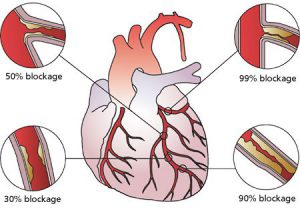Coronary Artery Disease
 Coronary artery disease develops when your coronary arteries become damaged or diseased. Coronary arteries are major blood vessels that give your heart blood and oxygen. Cholesterol containing deposits (plaque) on your arteries are usually to blame for coronary artery disease. When plaque builds up, this narrows your coronary arteries thereby causing your heart to receive less blood. The decreased blood flow may cause chest pain (angina), shortness of breath or other signs and symptoms. A 100% blockage can cause a heart attack.
Coronary artery disease develops when your coronary arteries become damaged or diseased. Coronary arteries are major blood vessels that give your heart blood and oxygen. Cholesterol containing deposits (plaque) on your arteries are usually to blame for coronary artery disease. When plaque builds up, this narrows your coronary arteries thereby causing your heart to receive less blood. The decreased blood flow may cause chest pain (angina), shortness of breath or other signs and symptoms. A 100% blockage can cause a heart attack.
The following tests are used in diagnosing coronary artery disease:
| Electrocardiogram (ECG) | Records electrical signals as they travel through your heart |
| Echocardiogram | Sound waves are used to make images of your heart |
| Stress test | Your doctor may ask you to walk on a treadmill or ride a stationary bike during and ECG – medication to stimulate your heart may be used instead of exercise |
| Nuclear stress test | Similar to a routine exercise stress test but with images in addition to an ECG |
| Cardiac catheterization or angiogram | Your doctor may inject a special dye into your arteries to view blood flow through your heart – if you have a blockage that requires treatment, a balloon can be used to push through the catheter and inflated to improve the blood flow in your coronary arteries. A mashed tube (stent) may then be used to keep the dilated artery open |
| CT scan | Helps the doctor visualize your arteries |
| Magnetic resonance angiography (MRA) | Uses MRI technology. It is often used with an injected dye, to check for areas of narrowing or blockages |
The judge at your Social Security disability hearing will want to know the extent of the blockages in your arteries. He or she will not know the seriousness of your coronary artery disease unless you can present credible medical evidence in the way of objective medical tests. The Social Security Administration places great emphasis on the treadmill test. The Bruce Protocol is the most commonly used protocol for the treadmill test and is the preferred test by the Social Security Administration. At your hearing, you will need to describe the chest pain in detail so that the judge will have a clear understanding of why you can’t work.
The New York heart Association has created guidelines that place the patient in different categories depending on the seriousness of the coronary artery disease:
| Class I | You have no limitation of activities; You have no symptoms from ordinary activities |
| Class II | You have a slight, mild limitation of activity; you are comfortable with rest or with mild exertion |
| Class III | You have marked limitation of activity; you are comfortable only at rest |
| Class IV | You should be at complete rest, you spend most of your time in bed or in a chair; any physical activity causes discomfort and symptoms occur at rest |
If you have coronary artery disease, you should talk to your doctor and find out which category you fall into under the New York Heart Association classification of limitations. The extent of the blockage and the degree of functional limitations need to be presented to the judge.
What Our Clients Say:
Member:

Attorney Gregory Kornegay
Greg is a trial attorney in Wilmington with over 30 years of experience. Greg was born and raised in southeastern North Carolina. Before law school he managed a store with employees making a payroll every week. His first job out of law school was as an Assistant District Attorney investigating and trying cases for the State of North Carolina. Through the years he has handled many different types of cases – including death penalty cases.
Being married with children has been a blessing and a challenge, but has served him well in understanding the problems individuals and families face as they live out their lives. Greg believes that each case is different and the needs of each client are unique, but there are certain themes of life that we all share.


